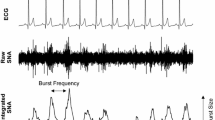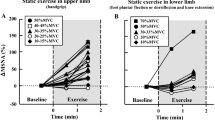Abstract
An overview is given of microneurographic studies of resting vasoconstrictor traffic in human muscle nerves (muscle sympathetic nerve activity = MSNA). In multiunit recordings, the activity consists of synchronized bursts of vasoconstrictor impulses, the outflow of which is under potent arterial baroreflex control. In agreement with this, the bursts always display cardiac rhythmicity and occur during temporary reductions of blood pressure. Burst occurrence shows a close inverse correlation to variations of diastolic blood pressure whereas the correlation to the strength of the bursts is weak or absent, suggesting that the mechanisms controlling the two parameters are not identical. These dynamic characteristics are similar in all subjects despite large, reproducible, interindividual differences in number of bursts. Such interindividual differences probably have a genetic origin, and since discharge frequencies in single vasoconstrictor fibers are similar in subjects with few and many bursts, the differences in multiunit activity are likely to be due to a higher number of active fibers in subjects with many bursts. The interindividual differences in multiunit activity are not associated with differences in resting blood pressure levels. Recent studies have revealed (a) an inverse relationship between resting levels of cardiac output and MSNA and (b) evidence of reduced vascular responsiveness to noradrenaline in subject with many sympathetic bursts at rest. These findings suggest that the vasoconstriction induced by the sympathetic impulses is balanced or reduced by these factors, which thereby contribute to the poor relationship between the mean number of sympathetic bursts and the blood pressure level.





Similar content being viewed by others
References
Charkoudian N, Joyner MJ, Johnson CP, Eisenach J, Dietz N, Wallin BG (2005) Balance between cardiac output and sympathetic nerve activity in resting humans: role in arterial pressure regulation. J Physiol (Lond) 568:315–321
Charkoudian N, Joyner MJ, Johnson CP, Sokolnicki LA, Eisenach JH, Dietz NM, Curry TB, Wallin BG (2006) Vascular adrenergic responsiveness is inversely related to tonic activity of sympathetic vasoconstrictor nerves in humans. J Physiol (Lond) 572:821–827
Delius W, Hagbarth K-E, Hongell A, Wallin BG (1972a) General characteristics of sympathetic activity in human muscle nerves. Acta Physiol Scand 84:65–81
Delius W, Hagbarth K-E, Hongell A, Wallin BG (1972b) Manoeuvres affecting sympathetic outflow in human skin nerves. Acta Physiol Scand 84:177–186
DiBona GF, Jones SY (1998) Reflex effects on components of synchronized renal sympathetic nerve activity. Am J Physiol 275:F441–F446
Elam M, McKenzie D, Macefield V (2002) Mechanisms of sympathoexcitation: single-unit analysis of muscle vasoconstrictor neurons in awake OSAS subjects. J Appl Physiol 93:297–303
Fagius J, Wallin BG, Sundlöf G, Nerhed C, Englesson S (1985) Sympathetic outflow in man after anaesthesia of glossopharyngeal and vagus nerves. Brain 108:423–438
Fagius J, Wallin BG (1993) Long-term variability and reproducibility of resting human muscle nerve sympathetic activity at rest, as reassessed after decade. Clin Auton Res 3:201–205
Gudbjörnsdottir S, Lönnroth P, Sverrisdottir YB, Wallin BG, Elam M (1996) Sympathetic nerve activity and insulin in obese normotensive and hypertensive men. Hypertension 27:276–280
Hagbarth K-E, Hallin RG, Hongell A, Torebjörk HE, Wallin BG (1972) General characteristics of sympathetic activity in human skin nerves. Acta Physiol Scand 84:164–176
Hagbarth K-E, Vallbo AB (1968) Pulse and respiratory grouping of sympathetic impulses in human muscle-nerves. Acta Physiol Scand 74:96–108
Jackson VM, Cunnane TC (2001) Neurotransmitter release mechanisms in sympathetic neurons: past, present, and future perspectives. Neurochem Res 26:875–889
Kienbaum P, Karlsson T, Sverrisdottir YB, Elam M, Wallin BG (2001) Two sites for modulation of human sympathetic activity by arterial baroreceptors? J Physiol (Lond) 531:861–869
Levine BD, Pawelczyk JA, Ertl AC, Cox JF, Zuckerman JH, Diedrich A, Biaggioni I, Ray CA, Smith ML, Iwase S, Saito M, Sugiyama Y, Mano T, Zhang R, Iwasaki K, Lane LD, Buckey JC Jr, Cooke WH, Baisch FJ, Eckberg DL, Blomqvist CG (2002) Human muscle sympathetic neural and haemodynamic responses to tilt following spaceflight. J Physiol (Lond) 538:331–340
Macefield VG, Wallin BG (1999) Firing properties of single vasoconstrictor neurones in human subjects with high levels of muscle sympathetic drive. J Physiol (Lond) 516:293–301
Macefield VG, Rundqvist B, Bergmann-Sverrisdottir Y, Wallin G, Elam M (1999) Firing properties of single muscle vasoconstrictor neurones in the sympathoexcitation associated with heart failure. Circulation 100:1708–1713
Macefield GV, Vallbo ÅB, Wallin BG (1994) The discharge behaviour of single vasoconstrictor motoneurones in human muscle nerves. J Physiol (Lond) 481:799–809
Macefield VG, Elam M, Wallin BG (2002) Firing properties of single postganglionic sympathetic neurones. Auton Neurosci 95:146–159
Malpas S, Ninomiya I (1992) Effects of chemoreceptor stimulation on the periodicity of renal sympathetic nerve activity in anesthetized cats. J Auton Nerv Syst 37:19–28
Nilsson H, Ljung B, Sjöblom N, Wallin BG (1985) The influence of sympathetic impulse pattern on contractile response of rat mesentric and veins. Acta Physiol Scand 123:303–309
Skarphedinsson JO, Elam M, Jungersten L, Wallin BG (1997) Sympathetic nerve traffic correlates to release of nitric oxide in humans: implications for blood pressure control. J Physiol (Lond) 501:671–675
Stjernberg L, Blumberg H, Wallin BG (1986) Sympathetic activity in man after spinal cord injury. Outflow to muscle below the lesion. Brain 109:695–715
Sundlöf G, Wallin BG (1977) The variability of muscle nerve sympathetic activity in resting recumbent man. J Physiol (Lond) 272:383–397
Sundlöf G, Wallin BG (1978) Human muscle nerve sympathetic activity at rest. Relationship to blood pressure and age. J Physiol (Lond) 274:621–637
Taddei S, Virdis A, Mattei P, Ghiadoni L, Gennari A, Fasolo CB, Sudano I, Salvetti A (1995) Aging and endothelial function in normotensive subjects and patients with essential hypertension. Circulation 91:1981–1987
Vallbo ÅB, Hagbarth K-E, Torebjörk HE, Wallin BG (1979) Somatosensory, proprioceptive and sympathetic activity in human peripheral nerves. Physiol Rev 59:919–957
Vallbo ÅB, Hagbarth K-E, Wallin BG (2004) Microneurography: how the technique developed and its role for the investigation of the sympathetic nervous system. J Appl Physiol 96:1262–1269
Wallin BG, Stjernberg L (1984) Sympathetic activity in man after spinal cord injury. Outflow to skin below the lesion. Brain 107:183–198
Wallin BG, Esler M, Dorward P, Eisenhofer G, Ferrier C, Westerman R, Jennings G (1992) Simultaneous measurements of cardiac noradrenaline spillover and sympathetic outflow to skeletal muscle in humans. J Physiol (Lond) 453:45–58
Wallin BG, Kunimoto M, Sellgren J (1993) Possible genetic influence on the strength of human muscle nerve sympathetic activity at rest. Hypertension 22:282–284
Wallin BG, Thompson JM, Jennings GL, Esler MD (1996) Renal noradrenaline spillover correlates with muscle sympathetic activity in humans. J Physiol (Lond) 491:881–887
Witzleb E (1983) Functions of the vascular system. In: Schmidt RF, Thews G (eds) Human physiology. Springer-Verlag, Berlin, Heidelberg, New York, pp 397–455
Yamada Y, Miyajima E, Tochikubo O, Matsukawa T, Ishii M (1989) Age-related changes in muscle sympathetic nerve activity in essential hypertension. Hypertension 13:870–877
Yeoh M, McLachlan E, Brock JA (2004) Chronic decentralization potentiates neurovascular transmission in the isolated rat tail artery, mimicking the effects of spinal transection. J Physiol (Lond) 561:583–596
Acknowledgement
Supported by Swedish Medical Research Council Grant 12170.
Author information
Authors and Affiliations
Corresponding author
Additional information
Based on a plenary lecture at the 16th meeting of the American Autonomic Society, Los Cabos, Mexico, October 2005.
Rights and permissions
About this article
Cite this article
Wallin, B.G. Regulation of sympathetic nerve traffic to skeletal muscle in resting humans. Clin Auton Res 16, 262–269 (2006). https://doi.org/10.1007/s10286-006-0357-0
Received:
Accepted:
Published:
Issue Date:
DOI: https://doi.org/10.1007/s10286-006-0357-0




